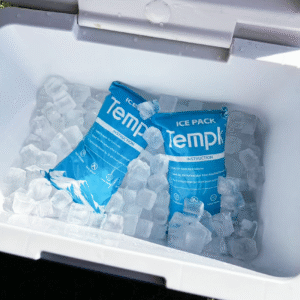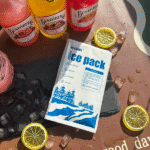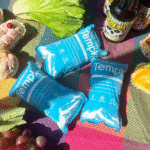Custo do pacote de gelo seco: 2025 Preços, Regras & ROI
Escolhendo o direito cost dry ice ice pack em 2025 directly lowers your total landed cost while protecting product quality. You’ll see real per‑pound pricing, typical surcharges, and right‑sizing rules you can copy today. In plain English, we show the math, when to switch to gel packs, and how to label shipments correctly for air and ground. You’ll also get a mini calculator and a quick checklist to apply on your next shipment.

-
Como dimensionar um cost dry ice ice pack for 24–120‑hour lanes without overspending
-
Qual 2025 surcharges and rules matter most for your cost dry ice ice pack
-
When PCMs beat a cost dry ice ice pack for 0–8 °C “do‑not‑freeze” freight
-
How to combine data loggers and insulation choices to reduce total cost
What drives the cost dry ice ice pack in 2025?
Resposta direta: Preço por libra, carrier dry‑ice fees, valor R de isolamento, calor ambiente, and failure risk are the big levers. Retail dry ice commonly lands between $1.60 e $3.00 por libra, and many air services add about an $8 dry‑ice fee por pacote. Plan around a 5–10 lb per‑day sublimation range and upgrade insulation where it’s cheaper than shipping extra weight. These figures synthesize current field data and carrier guidance.
cost_dry_ice_ice_pack
Por que isso importa para você: Think of heat as water leaking into a bucket. Better insulation shrinks the leak, so you buy less ice for the same lane. If you ship frozen goods for 2–3 days, Comece próximo 5 lb/day in tight EPS shippers and 8–10 lb/day in thin corrugate. Supplier tiers push unit price down as you buy more; pair with a neighbor to place a 100‑lb order and cut the per‑lb rate.
How much dry ice per day for common frozen lanes?
For mid‑size shippers, a practical range is 5–10 lb por 24 horas. Use the low end for dense EPS or VIP containers, and the high end for thin walls or hot routes. Record one run per lane with a data logger; you’ll know if you can trim ice or need a buffer for heat waves.
| Comprimento da pista | Base lb/day | Quando usar | O que isso significa para você |
|---|---|---|---|
| 24 h, EPS/VIP | 5 | Rotas suaves, ajuste apertado | Lower mass, lower freight weight |
| 48–72 h, EPS | 6–7 | Most frozen food | Balance weight and margin |
| 72–96 h, ondulado | 8–10 | Hot summers, paredes finas | Consider better insulation over more ice |
Dicas e sugestões práticas
-
Pistas quentes: Pre‑freeze payload and add a 20–30% buffer.
-
Pistas longas: Split ice along walls and lid to reduce hotspots.
-
Ultra‑frozen: Use gelo seco para ≤−50°C specs; PCMs alone won’t hold it.
-
Validação: Run a data‑logger trial for each lane and cost dry ice ice pack tamanho.
Caso real: A West‑coast bakery replaced gels with a 6 lb cost dry ice ice pack in an EPS cooler for two‑day air and cut claims ~30% with no base‑rate increase.
How do you size a cost dry ice ice pack without overspending?
Resposta curta: Use a repeatable estimator and validate with one timed trial. A popular shortcut for frozen lanes is payload weight × 0.6 × dias de trânsito. Cross‑check with the 5–10 lb/dia heuristic and adjust +20–30% for heat waves or thin corrugate.
Worked examples for fast budgeting
Exemplo A (2‑day air, EPS): 6 libra × $1.80 = $10.80 gelo + ~$8 dry‑ice fee + $3 materiais ≈ $21.80–$23.80.
Exemplo B (4Brasil de dia, ondulado): 18 libra × $1.60 = $28.80 gelo + $0–$8 taxa + $3.50 materiais ≈ $32.30–$40.30.
Exemplo C (3‑day air, rota quente): 29 libra × $2.20 = $63.80 + ~$8 taxa + $3.50 ≈ $75.30; upgrading insulation likely cheaper.
Gelo seco vs pacotes de gel: when is a cost dry ice ice pack the better choice?
Regra geral: Escolha gelo seco para ≤ -18 ° C. targets or longer lanes; choose PCMs/gel para 0–8 ° C. “do‑not‑freeze” products. Dry ice is single‑use but powerful; gels are reusable and avoid hazmat fees. Pacotes híbridos use a small cost dry ice ice pack plus PCMs to stage from frozen to chilled over 3–5 days.
| Método de resfriamento | Typical unit cost | Reutilizar | Regulatory burden | Melhor ajuste |
|---|---|---|---|---|
| Gelo seco | $1.60–$3.00 per lb | Use único | Aula 9 rótulo, ventilação, UN1845 | Keep products ≤−18 °C |
| PCM/gel | $2–$5 por pacote | Reutilizável | No hazmat for most lanes | Hold 0–8 °C or supplement dry ice |
Labeling and safety for any cost dry ice ice pack
Faça isso sempre: Air shipments must be vented and marked “Carbon Dioxide, sólido,” with UN1845 and net kg, mais uma aula 9 rótulo. Deixar 10–15% de espaço livre. CO₂ expands ~541 L per kilogram; nunca sele hermeticamente. A one‑page SOP with photos prevents relabel fees and delays.
-
Marca Gelo Seco / Dióxido de carbono, sólido.
-
Adicionar UN1845 e Peso líquido em kg (por exemplo, 6.0 kg).
-
Aplicar Aula 9 label on a vertical side.
-
Usar ventilado embalagem; never tape over vents.
Autoverificação rápida
-
We validated at least one lane with a data logger.
-
We documented UN1845 and net kg on every air carton.
-
We leave 10–15% headspace in every box.
-
We have a PCM alternative to a cost dry ice ice pack for 0–8 °C lanes.
-
We renegotiate dry‑ice tiers quarterly.
2025 trends that change your cost dry ice ice pack
O que há de novo: Expect steady per‑lb pricing with regional swings, modest carrier fee increases, and better insulation/monitoring tech. Portable dry‑ice generators and lighter VIP liners cut transport cost. Keeping both a cost dry ice ice pack and a PCM packout validated lets you switch when weather or price moves.
Latest updates at a glance
-
Taxas da transportadora: Muitos EUA. air services apply dry‑ice handling fees around $8 por pacote.
-
Supply: CO₂ availability can tighten locally; manter two suppliers.
-
Tecnologia: Cheaper cloud data loggers make quarterly lane validation fácil.
-
Materiais: Novo Forros VIP reduce ice mass without hurting hold time.
Insight de mercado: Modelo two packouts per lane and negotiate surcharge terms annually. When energy costs spike or heat waves hit, switching to higher‑R packaging often beats shipping another 5–10 lb per day of a cost dry ice ice pack.
Perguntas frequentes
What does a cost dry ice ice pack include?
It means the ice mass, taxa da operadora, materiais, trabalho, and expected risk cost—use all five to compare options.
Is dry ice hazardous?
Sim. It is regulated in air transport; packages must vent and be labeled. Train staff and meter CO₂ in staging areas.
How much headspace do I need?
Objetivo para 10–15% free volume and keep vents open; CO₂ expands fast as the ice sublimates.
Can I ship dry ice by ground without hazmat paperwork?
With non‑dangerous goods, you typically need proper labels and venting, not a full hazmat declaration. Confirm your carrier guide.
How many pounds per day should I plan?
Comece com 5–10 lb por 24 horas and validate with a logger on your own lanes.
Resumo e recomendações
Pontos -chave: Seu cost dry ice ice pack is driven by price per lb, carrier fees, isolamento, calor ambiente, and risk. Right‑size with simple math, rotular corretamente, deixe o espaço livre, and keep a PCM option for chilled lanes. Validate with a data logger and revisit tiers with suppliers once per quarter.
PRÓXIMOS PASSOS: Run the estimator for your top five lanes, then A/B test insulation vs ice mass. Refresh your labeling SOP and schedule a quarterly lane validation. CTA: Contact Tempk for a lane‑by‑lane packout and cost model.
Sobre Tempk
We design validated dry‑ice and PCM packouts, remetentes isolados, and labeling SOPs. Nós ajudamos comida, farmacêutico, and biotech teams cut claims by 20–40% and reduce landed cost by 10–25% by right‑sizing coolant and improving insulation.























